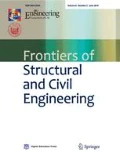Abstract
The advanced design rules and the latest known earthquakes, have imposed a strengthening of reinforced concrete structures. Many research works and practical achievements of the application of the external reinforcement by using FRP composite materials have been particularly developed in the recent years. This type of strengthening seems promising for the seismic reinforcement of buildings. Among of the components of structures that could affect the stability of the structure in case of an earthquake is the reinforced concrete walls, which require in many cases a strengthening, especially in case where the diagonal cracks can be developed. The intent of this paper is to present a numerical simulation of squat reinforced concrete wall strengthened by FRP composite material (carbon fiber epoxy). The intent of this study is to perform finite element model to investigate the effects of such reinforcement in the squat reinforced concrete walls. Taking advantage of a commercial finite element package ABAQUS code, three-dimensional numerical simulations were performed, addressing the parameters associated with the squat reinforced concrete walls. An elasto-plastic damage model material is used for concrete, for steel, an elastic-plastic behavior is adopted, and the FRP composite is considered unidirectional and orthotropic. The obtained results in terms of displacements, stresses, damage illustrate clearly the importance of this strengthening strategy.
Similar content being viewed by others
References
Victor DAVIDOVICI. 2003 Earthquake of BOUMERDES–21 May 2003. Preliminary Report, Ministry of Housing, Democratic Republic of Algeria. June 8, 2003
Antoniades K, Salonikios T, Kappos A. Tests on seismically damaged reinforced concrete walls repaired and strengthened using fiber-reinforced polymers. Journal of Composites for Construction, 2005, 9(3): 236–246
Paterson J, Mitchell D. Seismic retrofit of shear walls with headed bars and carbon fiber warp. Journal of Structural Engineering, 2003, 129(5): 606–614
Elnashai A S, Sarno L D. Fundamentals of Earthquake Engineering, Chapter 3: Earthquake Input Motion. John Wiley & Sons, England, 2008
Abaqus. Version 6.8.1 HKS, Inc, Providence, RI, 2008
Greifenhagen C, Lestuzzi P. Static cyclic test on lightly reinforced concrete shear walls. Engineering Structures, 2005, 27(11): 1703–1712
Paulay T, Priestley M J N. seismic design of reinforced concrete and masonry buildings. New York: John Willy and Sons Inc, 1992
Ferrier E, Colomb P, Hamelin P. Behavior of reinforced concrete structures reinforced with FRP composite vis-à-vis their application materials seismic compliance. Colloque AFPS. Paris (France), 2007
Cavaleri L, Miraglia N, Papia M. Pumice concrete for structural wall panels. Engineering Structures, 2003, 25(1): 115–125
Lefas L D, KosovosM D, Ambraseys N N. Behavior of reinforced concrete structural walls: Strength, deformation Characteristics, and failure mechanism. ACI Structural Journal, 1990, 87(6): 23–31
Lubliner J, Oliver J, Oller S, Onate E. A plastic-damage model for concrete. International Journal of Solids and Structures, 1989, 25(3): 299–326
Lee J, Fenves G L. Plastic-damage model for cyclic loading of concrete structures. Journal of Engineering Mechanics 8, 1998, 124(8): 892–900
Hillerborg A, Modeer M, Petersson P E. Analysis of crack formation and crack growth in concrete by means of fracture mechanics and finite elements. Cement and Concrete Research, 1976, 6(6): 773–781
Rots J G. Computational modeling of concrete fracture. Dissertation for the Doctoral Degree, Delft University of Technology, Pays-Bas, 1988
Hollaway L, Leeming M B. Strengthening of Reinforced Concrete Structures: Using Externally-bonded FRP Composites in Structural and Civil Engineering. Woodhead Publishing Limited, Abington Hall, Abington Cambridge Cb1 6AH, England, 1999
Kollár L P, George S. Mechanics of Composite Structures. Cambridge University Press, United Kingdom, 2003
Author information
Authors and Affiliations
Corresponding author
Rights and permissions
About this article
Cite this article
Kezmane, A., Boukais, S. & Hamizi, M. Numerical simulation of squat reinforced concrete wall strengthened by FRP composite material. Front. Struct. Civ. Eng. 10, 445–455 (2016). https://doi.org/10.1007/s11709-016-0339-9
Received:
Accepted:
Published:
Issue Date:
DOI: https://doi.org/10.1007/s11709-016-0339-9




